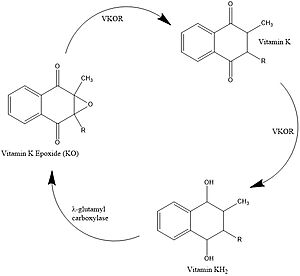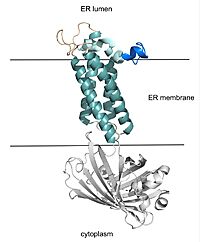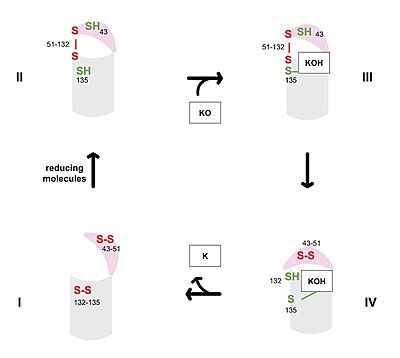Sandbox Reserved 1724
From Proteopedia
(Difference between revisions)
| Line 18: | Line 18: | ||
===Overview=== | ===Overview=== | ||
| + | [[Image:Vkor_cat_cycle_jpeg.jpg|400 px|right|thumb|Figure 1. Catalytic Cycle of VKOR]] | ||
| + | |||
The catalytic cycle shows how vitamin K epoxide reductase structurally transforms from an open wild type conformation to having several different types of substrates within its binding pocket. The first step of the catalytic cycle of shown to the right is the wild type open conformation, <scene name='90/904329/Cat_cycle_i/1'>step I</scene>. This step is characterized by an open cap domain with a disulfide bond (43-51) and a second disulfide bond (132-135) in the alpha helices. As shown this step can be characterized as closed when warfarin sits within the binding pocket without the disulfide bonds changing so that the cap domain does not actually close. This step is considered closed because vitamin K would not be able to enter the binding pocket in any of its forms. The second step of the catalytic cycle is a closed conformation, <scene name='90/904329/Cat_cycle_2/1'>step II</scene>. This step is characterized by a disulfide bond between the cap domain and alpha helices (51 and 132), with both containing an SH group. Warfarin can sit within this structure without disrupting and of these sulfur groups. The next step of the cycle, <scene name='90/904329/Cat_cycle_3/5'>step III</scene>, is slightly different because KOH or KH (depending on the step of the vitamin K cycle) binds to the cysteine 135 within the alpha helices. This is also a closed structure. Lastly, <scene name='90/904329/Cat_cycle_4/1'>step IV</scene> of the catalytic cycle is also a closed structure. The major difference is the orientation of the disulfide and cysteine interactions. | The catalytic cycle shows how vitamin K epoxide reductase structurally transforms from an open wild type conformation to having several different types of substrates within its binding pocket. The first step of the catalytic cycle of shown to the right is the wild type open conformation, <scene name='90/904329/Cat_cycle_i/1'>step I</scene>. This step is characterized by an open cap domain with a disulfide bond (43-51) and a second disulfide bond (132-135) in the alpha helices. As shown this step can be characterized as closed when warfarin sits within the binding pocket without the disulfide bonds changing so that the cap domain does not actually close. This step is considered closed because vitamin K would not be able to enter the binding pocket in any of its forms. The second step of the catalytic cycle is a closed conformation, <scene name='90/904329/Cat_cycle_2/1'>step II</scene>. This step is characterized by a disulfide bond between the cap domain and alpha helices (51 and 132), with both containing an SH group. Warfarin can sit within this structure without disrupting and of these sulfur groups. The next step of the cycle, <scene name='90/904329/Cat_cycle_3/5'>step III</scene>, is slightly different because KOH or KH (depending on the step of the vitamin K cycle) binds to the cysteine 135 within the alpha helices. This is also a closed structure. Lastly, <scene name='90/904329/Cat_cycle_4/1'>step IV</scene> of the catalytic cycle is also a closed structure. The major difference is the orientation of the disulfide and cysteine interactions. | ||
===Catalytic Cysteines=== | ===Catalytic Cysteines=== | ||
| - | |||
There are 4 catalytic cysteines that are important to VKOR, 43, 51, 132, and 135. To explain how this works, it is easiest to start with the second state. In the second state, an oxidized or partially oxidized Vitamin K has entered the active site. The stabilizing 51-132 disulfide bond is shown. Then in the third state, 43 has attacked the disulfide bond and made its own bond with 51. You can see 132 has an oxygen. That is because the researchers made a mutation from S to O to force the reaction to stop at that step so the structure could be deduced. In the natural VKOR, that would be a sulfur. The next state, the open state, results from 132 forming a bridge with 135. This allows release of the reduced or partially reduced Vitamin K. All of this disulfide rearranging was working to reduce the Vitamin K, particularly in the 135 position. If we go back to State 2, when Vitamin K first binds, you can see that 135 is not tied up in a disulfide bond. It is available to help the Vitamin K bond. So, it makes sense that once 135 gets forced to bond, the now reduced Vitamin K is released. State 5 is interesting because the disulfide bonds are similar to the open state, but warfarin is actually bound. This represents the binding of warfarin to the fully oxidized VKOR at the end of its cycle. Going back to State 1, the researchers used a mutation at 43 to mimic VKOR’s partially oxidized state. Warfarin can also bind to this state and notice that the disulfide bonds are the same as State 2. Also it is worth pointing out how the disulfide bonds contribute to conformational changes and are affected by conformational changes, which affects their proximity to each other and the active site. | There are 4 catalytic cysteines that are important to VKOR, 43, 51, 132, and 135. To explain how this works, it is easiest to start with the second state. In the second state, an oxidized or partially oxidized Vitamin K has entered the active site. The stabilizing 51-132 disulfide bond is shown. Then in the third state, 43 has attacked the disulfide bond and made its own bond with 51. You can see 132 has an oxygen. That is because the researchers made a mutation from S to O to force the reaction to stop at that step so the structure could be deduced. In the natural VKOR, that would be a sulfur. The next state, the open state, results from 132 forming a bridge with 135. This allows release of the reduced or partially reduced Vitamin K. All of this disulfide rearranging was working to reduce the Vitamin K, particularly in the 135 position. If we go back to State 2, when Vitamin K first binds, you can see that 135 is not tied up in a disulfide bond. It is available to help the Vitamin K bond. So, it makes sense that once 135 gets forced to bond, the now reduced Vitamin K is released. State 5 is interesting because the disulfide bonds are similar to the open state, but warfarin is actually bound. This represents the binding of warfarin to the fully oxidized VKOR at the end of its cycle. Going back to State 1, the researchers used a mutation at 43 to mimic VKOR’s partially oxidized state. Warfarin can also bind to this state and notice that the disulfide bonds are the same as State 2. Also it is worth pointing out how the disulfide bonds contribute to conformational changes and are affected by conformational changes, which affects their proximity to each other and the active site. | ||
Revision as of 01:15, 29 March 2022
| This Sandbox is Reserved from February 28 through September 1, 2022 for use in the course CH462 Biochemistry II taught by R. Jeremy Johnson at the Butler University, Indianapolis, USA. This reservation includes Sandbox Reserved 1700 through Sandbox Reserved 1729. |
To get started:
More help: Help:Editing |
Vitamin K Epoxide Reductase
| |||||||||||
References
- ↑ Stafford DW. The vitamin K cycle. J Thromb Haemost. 2005 Aug;3(8):1873-8. doi: 10.1111/j.1538-7836.2005.01419.x. PMID:16102054 doi:http://dx.doi.org/10.1111/j.1538-7836.2005.01419.x
- ↑ Liu S, Li S, Shen G, Sukumar N, Krezel AM, Li W. Structural basis of antagonizing the vitamin K catalytic cycle for anticoagulation. Science. 2020 Nov 5. pii: science.abc5667. doi: 10.1126/science.abc5667. PMID:33154105 doi:http://dx.doi.org/10.1126/science.abc5667
Student Contributors
Izabella Jordan, Emma Varness



